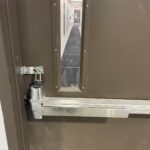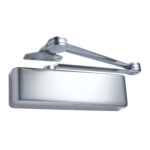 That’s the question I was asked on Friday…“If someone orders a delayed egress exit device or delayed egress mag-lock, when do they need the ‘BOCA’ feature?”
That’s the question I was asked on Friday…“If someone orders a delayed egress exit device or delayed egress mag-lock, when do they need the ‘BOCA’ feature?”
Incidentally, the person who asked me the question was one of my college classmates. There are actually a few graduates of Vermont Technical College who ended up in the door and hardware business. Can you identify any of them? –>
(If you’re a VTC alum, send me your yearbook photo!)
So back to the question…When do you need to add the BOCA feature to a delayed egress lock? For some background information about delayed egress locks, refer back to this post.
The code requirements for delayed egress locks vary depending on which code is being enforced. Here’s a refresher of a few of the differences:
- NFPA 101 – Initiate 15-second timer by applying force for 3 seconds. When the lock has been released by the application of force, the lock must be rearmed manually.
- IBC – Initiate 15-second timer by applying force for 1 second. When the lock has been released by the application of force, lock must be rearmed manually.
- BOCA – Initiate 15-second timer by applying force for 1 second. After the lock has been released by the application of force, lock may be automatically rearmed after door opens, closes and stays closed for at least 30 seconds.
Most jurisdictions that were previously using the BOCA National Building Code have now adopted the International Building Code (IBC). The BOCA requirement which allowed automatic rearming of the lock could be considered more secure, but could negatively impact life safety. With the NFPA 101 and IBC requirements, the first person who exits would wait 15 seconds but there is no delay for subsequent occupants. With the BOCA requirements, the first occupant waits 15 seconds, and if 30 seconds passes and the lock rearms, the next occupant would have to wait for 15 seconds as well. This scenario would be repeated each time the door opened, closed, and stayed closed for 30 seconds. Some code officials required manual rearming of the lock even when the BOCA code was being enforced, because they considered the automatic rearming function detrimental to life safety.
The BOCA feature gives a delayed egress lock the ability to meet the BOCA requirements (a door position switch may be also be required depending on the product used). Since most jurisdictions are no longer using the BOCA code, and the requirements of NFPA 101 and the IBC are preferred from a life-safety standpoint, the use of the BOCA option will likely become less common.
You need to login or register to bookmark/favorite this content.







It has been my expierence that the 1 vs 3 second nusiance alarm is the most critical component in a
health care occupancy. The owner’s would like no nusiance alarm so they would rather have 3 second.
I happen to explain this at a spec meeting with architect, engineers and onwers. And I said that I
spec the normal (non BOCA option)product. What I did not realize was that in attendance at the meeting
was the RISK Assesment Manager for the hospital. I was immediately informed that I HAD to follow the
code.
Years ago (10 ) I was specing the BOCA option on CX devices and had many unhappy hospitals.